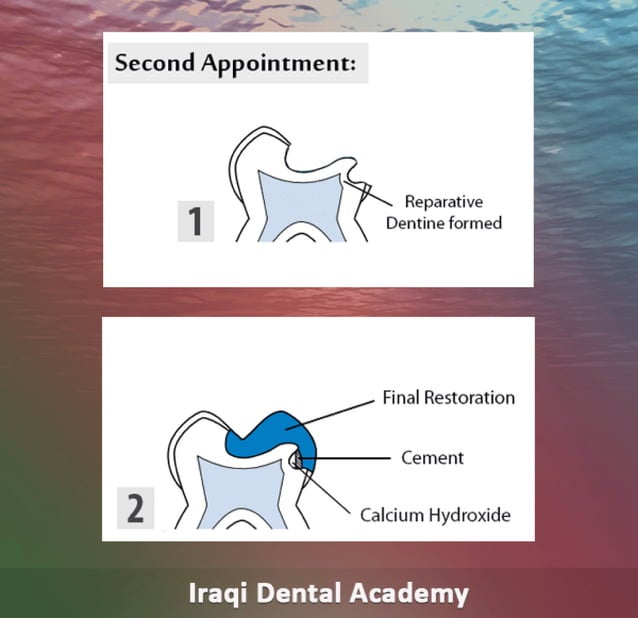Indirect Pulp Capping Techniques Explained

The realm of dentistry is vast and intricate, with various techniques aimed at preserving the health and integrity of teeth. Among these, indirect pulp capping stands out as a procedure designed to protect the pulp, the soft tissue within the tooth containing nerves and blood vessels, from further injury. This method is particularly useful when a dentist aims to avoid exposing the pulp during the removal of decay or damaged tooth structure. In this context, understanding the indirect pulp capping techniques is crucial for both dental professionals and patients seeking to preserve their oral health.
Introduction to Indirect Pulp Capping
Indirect pulp capping is a dental procedure that involves placing a protective material on top of a nearly exposed pulp, without directly exposing it. This approach is adopted when the decay is close to the pulp but hasn’t reached it yet. The primary goal is to protect the pulp, allowing the tooth to heal and potentially avoid the need for more invasive treatments like root canal therapy. The success of indirect pulp capping largely depends on the accurate diagnosis of the pulp’s condition and the proper application of the capping material.
Materials Used for Indirect Pulp Capping
Several materials can be used for indirect pulp capping, each with its unique properties and indications. These include:
Calcium Hydroxide: Historically, calcium hydroxide has been a gold standard for pulp capping due to its high pH, which can stimulate the formation of dentin bridges. However, its use has declined somewhat due to concerns over its potential to cause necrosis of the pulp tissue underneath.
Mineral Trioxide Aggregate (MTA): MTA has gained popularity for its biocompatibility and ability to promote the formation of dentin bridges. It is highly effective but can be challenging to handle due to its long setting time and potential for discoloration.
Resin-based Materials: These materials, such as resin-modified glass ionomer cements, offer a faster setting time and improved sealing ability compared to calcium hydroxide and MTA. They are less irritating to the pulp and can bonded directly to the tooth structure.
Bioceramic Materials: Newer to the scene, bioceramic materials are being explored for their potential in pulp capping. They offer good biocompatibility, the ability to promote healing, and a more favorable environment for the formation of dentin.
Techniques for Indirect Pulp Capping
The technique for indirect pulp capping involves several steps:
- Removal of Decay: The dentist carefully removes the decayed portion of the tooth, stopping just short of exposing the pulp.
- Inspection: The area is inspected to ensure no pulp exposure has occurred.
- Application of Capping Material: The chosen material is then applied directly onto the remaining dentin, covering the area where the pulp is closest to the surface.
- Restoration: Finally, the tooth is restored with a filling material to protect it from further decay and allow normal function.
Success Rates and Considerations
The success of indirect pulp capping depends on various factors, including the depth of decay, the material used, and the patient’s overall health. While indirect pulp capping can be highly effective, there are instances where the pulp may still become infected or necrotic, necessitating a root canal. Regular follow-up appointments are crucial to monitor the tooth’s response to the procedure.
Future Directions
As dental materials and techniques evolve, so too do the approaches to indirect pulp capping. Research into bioactive materials that can stimulate the pulp to produce secondary dentin, potentially avoiding the need for capping, is ongoing. Additionally, advancements in diagnostic tools, such as laser fluorescence devices, are helping dentists more accurately assess the vitality of the pulp, making indirect pulp capping a more predictable procedure.
Conclusion
Indirect pulp capping represents a conservative approach to managing deep caries lesions, aiming to preserve the pulp’s health and avoid more extensive treatments. With the variety of materials available and the continually improving techniques, dentists can offer patients a viable option for tooth preservation. As with any dental procedure, proper case selection, meticulous technique, and thorough follow-up care are key to the success of indirect pulp capping.
What is the primary goal of indirect pulp capping?
+The primary goal of indirect pulp capping is to protect the pulp from further injury, allowing the tooth to heal and potentially avoid the need for more invasive treatments like root canal therapy.
What materials are commonly used for indirect pulp capping?
+Common materials include calcium hydroxide, mineral trioxide aggregate (MTA), resin-based materials, and bioceramic materials. Each has its unique properties and indications.
How is indirect pulp capping performed?
+The procedure involves the careful removal of decay, inspection to ensure no pulp exposure, application of the chosen capping material, and finally, restoration of the tooth with a filling material.
In conclusion, indirect pulp capping techniques offer a promising approach to preserving tooth health, especially in cases where the pulp is at risk but not yet exposed. By understanding the materials, techniques, and considerations involved, both dental professionals and patients can make informed decisions about this valuable procedure.